IELTS Task 1 Questions – Process Diagrams
Before you start learning how to describe Process Diagrams in IELTS Task 1, it would be useful for you to study these articles first.
If you are familiar with the content, you can continue to the next section.
IELTS TASK 1 Describing changes and trends
IELTS TASK 1 Working correctly with numbers
IELTS TASK 1 Increase your band score with Adjectives/Adverbs
IELTS TASK 1 Using Compare and Contrast language
When writing about Process Diagrams there are usually two main features that you need to notice – the order and stages of the process presented, what kind of process it is and whether it is one process or repeated.
For this type of essay it is standard to write a four paragraph essay, namely An Introduction, An Overview and probably one or two body paragraphs.
Have a look at my articles below if you need further information
You can now study the Process Diagrams below and look at the suggested structure:
IELTS Writing Task 1: Describing a Process Questions
Although it’s a less common type of question in the writing test (you’re more likely to get a Graph and Chart question) sometimes you will get an IELTS Process Diagram that needs to be described.
This format of question is very visual and therefore seems easier to answer than other formats, and because they are less common, students often prepare less for it.
This is a mistake as it is really important to be prepared for all types of IELTS questions. But, the good news is that the preparation won’t take as long as you might think.
Good News!
Process Questions follow the same format as any IELTS Task 1:
This is
- Introduce the diagram
- Give an overview of the main point/s (necessary for Band 6 and above)
- And provide the detail
This post will explain:
- The two types of process question
- The tried and tested method for answering any process question
- How to write the introduction
- How to write about the detail in sequence
- How to finish with a great overview
- The commons mistakes IELTS students make
What is an IELTS Process Question?
These questions can be divided into two types: natural cycles and man-made processes.
Official IELTS practice questions have featured natural cycles such as the life cycle of frogs, moths or butterflies, the natural water cycle or how cows produce milk for their calves.
In contrast, practice questions have included man-made processes such as how coffee, tea or leather is made, bricks are produced or a satellite signal is transmitted and received.
More good news is that the same skills and principles can be applied to both man-made and natural cycles.
Let’s consider a typical question first.
Here is the diagram we are going to use.
A Good Teacher’s Guide to IELTS Planning.
Any good teacher will tell you that to be effective in Task 1 you need to understand the task quickly and plan an answer quickly too. You can do this like so:
Get an overall visual understanding of the process
- Paraphrase the question
- Consider an overview
- Divide the process into parts
- Include time to proofread your writing
Gaining an overall understanding of the process
A process has a number of stages that are in time ordered. So, you should start at the beginning, follow the process and describe each stage through to the final one.
In the example above, this is fairly obvious. It begins with the removal of clay, and ends with delivery of the finished product.
However, processes are not always as clear as this, and you may need to look more carefully to notice the beginning, and two things may happen at the same time. In this example, it’s clear that two processes might take place as one arrow becomes two, for example, the bricks are moulded or cut.
It’s quite a challenge to write about something you have never seen, so it is important that you look at other sample processes to get a good understanding of how they might vary.
Don’t worry, it doesn’t need to be perfect, you only have 15 minutes and just need to notice the main features and report them in an accurate way.
TOP TIPS for understanding
- Identify where the process begins and ends
- Is it a circular process or linear with a start and a finish?
- Count the number of stages?
- Is it natural or a man-made process?
- Is anything added to the process?
- What is the function of each stage of the process?
- Is there a relationship between these stages?
- What is produced at the end?
By answering these questions you will have already started planning your essay
Good News – Remember the IELTS task is not there to trick you, and you won’t be given a complicated process to describe. Your task is to report effectively and accurately.
Introduce the Diagram
Top Tip
As with any Task 1, you can begin by paraphrasing sentence (1)
This is the rubric or instructions.
Paraphrasing is a task that is worth learning to do well, and a good knowledge of paraphrasing will also help you in the Reading, Listening and Speaking part of the test.
Simply put, paraphrasing for IELTS means using different words and/or word order so the original meaning remains the same.
In order to remain the same, different words need to be synonyms, so Man, male and person have a similar meaning, they are synonymous, but man, male, person and girl are not all synonymous.
As you can see, all the information in the three sentences has been taken from the question, but it has not been copied.
BAD NEWS
If you do copy directly then those words are not used towards the word count and you will fail on TASK ACHIEVEMENT.
You need to write it in your own words.
In any Academic Task 1 question you can rewrite (paraphrase) the questions and this will be the first paragraph. Well done! You can then move on further and consider the next section, the Overview.
Overview of the Process
The ‘public band descriptors’ state that to achieve a Band 6 or above for ‘task response’ the student must provide an overview in a Task 1. Without one, you are less likely to get a high score.
If you started planning at the beginning then writing a good overview will be a lot easier near the end.
Remember, the questions I asked you to consider. These should be sufficient to provide the 2 sentences you need to construct the basic overview.
Recap:
- Where does the process begin and end?
- Circular process or linear with a start and a finish?
- Number of stages?
- Natural or a man-made process?
- Additions to the process?
- What is produced at the end
An IELTS process diagram is different to a chart or table as there aren’t usually any key changes or trends to identify.
So, as there are no trends to comment on, you could mention, for example, the number of stages in the process and how it begins and ends instead.
Providing the Detail
Now that you have completed paraphrasing the question and given the overview, the next stage is to explain the IELTS process diagram in detail.
You can do this by:
- Stating what each stage does
- What is produced?
- Are any materials added?
- Is there a relationship between stages?
Before you do this you need to consider the most suitable language that reflects the sophistication of the task.
Consider the most suitable language
In order to describe the process well there are two key aspects of language to be considered. These are sequencing and choice of grammar.
1) Time Connectors
As a process is a series of events, for example, one taking place after the other, to connect your stages, you should sequence them using suitable ‘time connectors’.
By using these well, your writing instantly becomes more logical, cohesive, sophisticated and most importantly, more impressive to the examiner.
Here is my sample answer with the time connectors highlighted that simply describe from the start to the end of the process.
Other examples of sequencing Time Connectors are:
BUT you need to be familiar with the meaning and correct use of these words so you need to have practised using them well.
If you use one incorrectly, it will stand out and be noted and penalised by the examiner.
For example, BEFORE means that you will mention a later stage first and then an earlier stage, as in this example
Before being dried, the mixture is shaped into bricks by placing into a mould or using a wire cutter.
So be careful.
2) Passive Tense
When we describe an IELTS process, the focus is on the activities in the process rather than the person.
So to describe the activities you use passive, not the active grammar.
If you need to know more about the Passive voice you can read the review below, but the good news is
- The IELTS task will provide most of the verbs that you need to use
- Using the passive will avoid using the words as they appear in the text
- You only need to use the passive in the present simple tense – that’s the Present Simple Passive
Most sentences use this structure:
- Subject + Verb + Object
- A mechanical digger removes the clay from the ground.
In this active voice the digger does the verb i.e. the digger is doing the digging.
In the passive voice,
- the object (the clay) becomes the subject,
- and the subject (the digger) becomes the object.
- and the verb ‘to be’ and the past participle (or Verb 3) is also added.
Compare:
A mechanical digger removes the clay from the ground.
The clay from the ground is removed by a mechanical digger.
The second example is far more appropriate for the IELTS Process Diagram question and far more sophisticated in choice of language.
Most of the description in your IELTS process diagram will use the passive voice but some verbs cannot be passive so are written as active.
An example of this ‘go’
‘the bricks go through a heating and cooling process.’
A solution to this problem might be to use a synonymous word, as in this example I have used in the final text
the bricks are put through a heating and cooling process
Here’s my example. I’ve highlighted the passives in the text.
Varying your language
One final tip for a higher score is variation in language.
Occasionally, it may be appropriate just to use the same language that you are given in the IELTS process diagram to describe it, but you should try to vary it.
You may be able to use nouns from the diagram as your verbs.
For example, the noun packaging near the end of the process becomes:
Finally, the bricks are packed.
Common Errors
A very basic error seen in Task 1 introduction is basic verb agreement.
Look at the two genuine examples below.
The image show
The diagrams shows
In both examples it is unclear about the number of nouns discussed
Here is the correction:
Common Errors using the Present Simple Passive
- Make sure you practise the passive so you know exactly how to use it.
Also, as you will see from the description, it is more unusual to comment on who or what is doing the action so the ‘by….” phrase is often excluded.
- Singular or Plural
Notice these examples are incorrect.
The brick are dried the bricks is dried
This is a really common mistake In Task 1 writing!
Here are the corrections:
Finally, check your Essay
Ideally, you need to allow 3 to 4 minutes at the end of the test to check and improve your writing. Often students don’t do this because they spend 20 minutes writing, but it is far better to write for about 15 minutes and allow 5 minutes to check and improve your writing.
From my experience the points you should check for are:
- Are there any obvious spelling or punctuation errors?
- Are the verbs the correct tense?
Additionally, you should consider these questions, but if you followed my planning advice you should be ok.
- Do the verbs agree with the subject?
- Does the process make sense? Does it follow the visual?
- Is there any repetition in vocabulary?
- Could this be improved with synonyms?
- Have I written over 150 words?
- Have I organised the text into at least 3 paragraphs?
- Have I noticed only the obvious features from the diagram?
- Have I included the prominent features in the overview?
- Have I NOT included my personal opinion?
Once you have done this, be proud of the final product!
The diagram illustrates the process that is used to manufacture bricks for the building industry.
Summarise the information by selecting and reporting the main features and make comparisons where relevant.
Write at least 150 words.
Here’s my sample.
Sample Answer Process Diagrams.
The diagram shows the process used to make bricks for use in the building industry.
To begin, the clay used to make the bricks is removed from the ground by a mechanical digger. This clay is then placed onto a metal grid, which is used to break down the clay into smaller pieces. A roller assists in this process.
Following this, sand and water are added to the clay, and this mixture is transformed into brick by either placing it into a mould or using a wire cutter. After that, the bricks are placed in an oven to dry for between 24 to 48 hours.
In the final stages, the bricks are put through a heating and cooling process. They are heated in a kiln at a moderate and then a high temperature (ranging from 200c to 1300c), followed by a cooling process in a kiln cooling chamber for 2 to 3 days. Finally, the bricks are removed, packed, and delivered to their final destinations.
Overall, there are eight stages in the process, beginning with the removal of clay from the ground and finishing in the delivery of the final product. Despite the use of modern machinery and tools, the production of brick remains a lengthy and complex process.
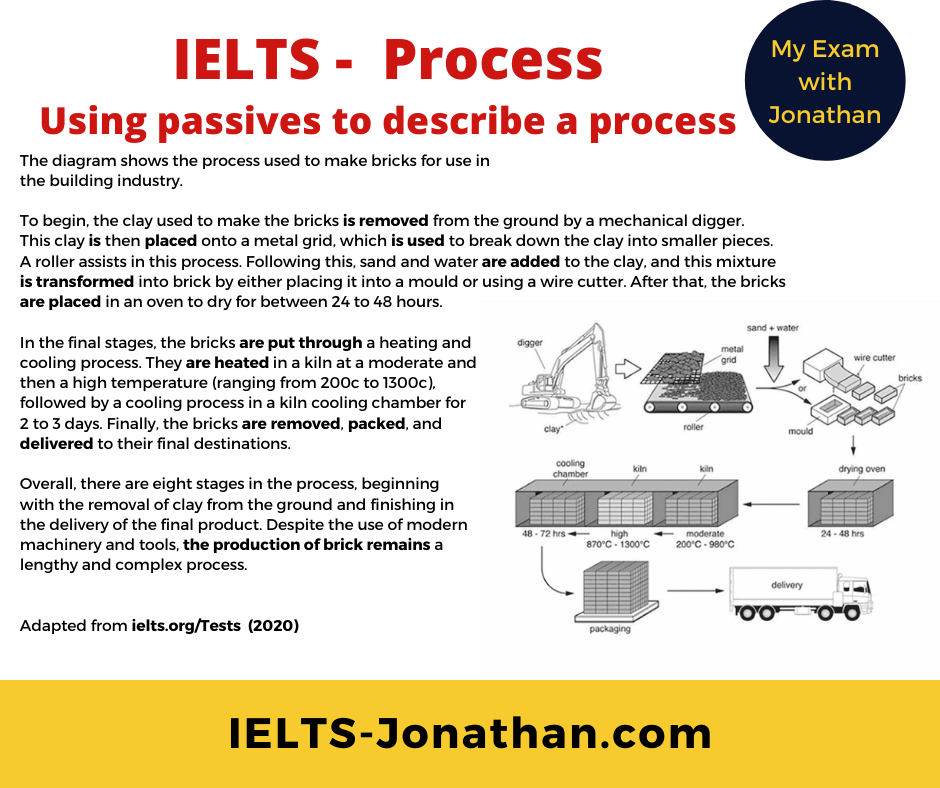
I hope you found this article useful. Comments are welcome and so is sharing!
Jonathan
I’m Jonathan
I’ve taught IELTS and University English in more than a dozen universities and schools around the world.
I’m a parent, traveller and passionate about language teaching and helping students achieve their dreams.
Whilst living in Austria or working in Asia, I run IELTS courses to help students get to where they want to be.
If you are serious about IELTS, connect with me to see how I can help you.

The Best Approach to Task 2 Writing
Paragraphing in Task 2 Writing
Writing – Benefits of a Foreign University Education
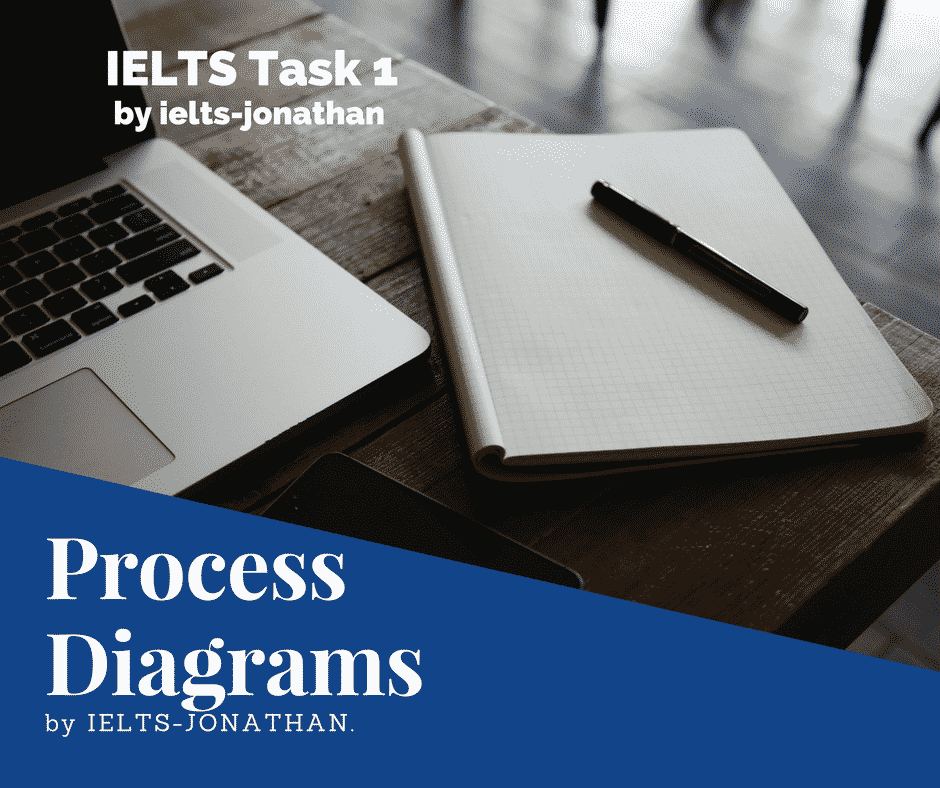
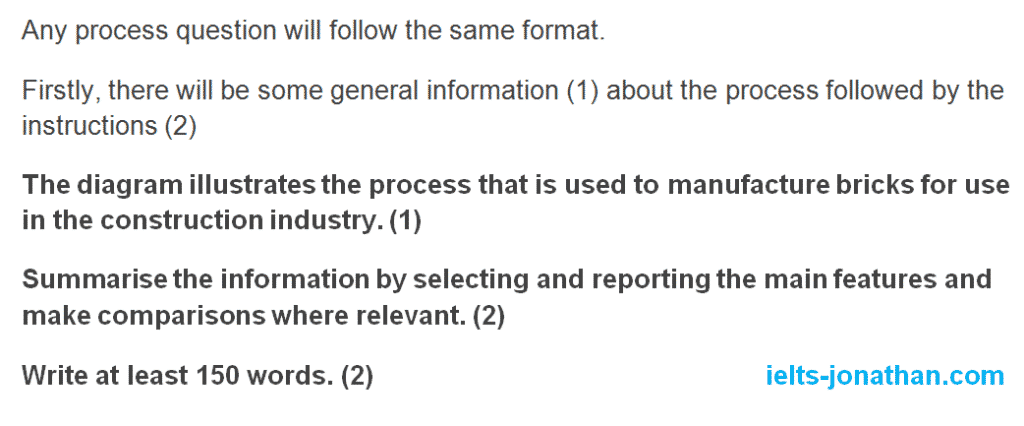
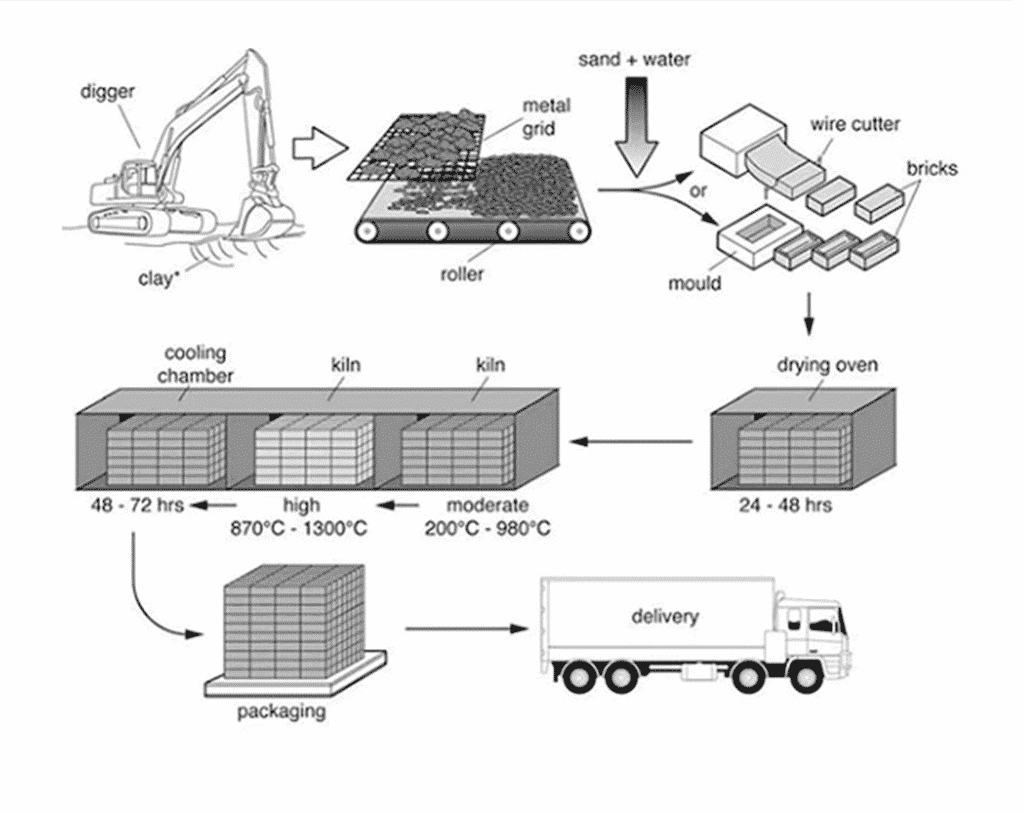
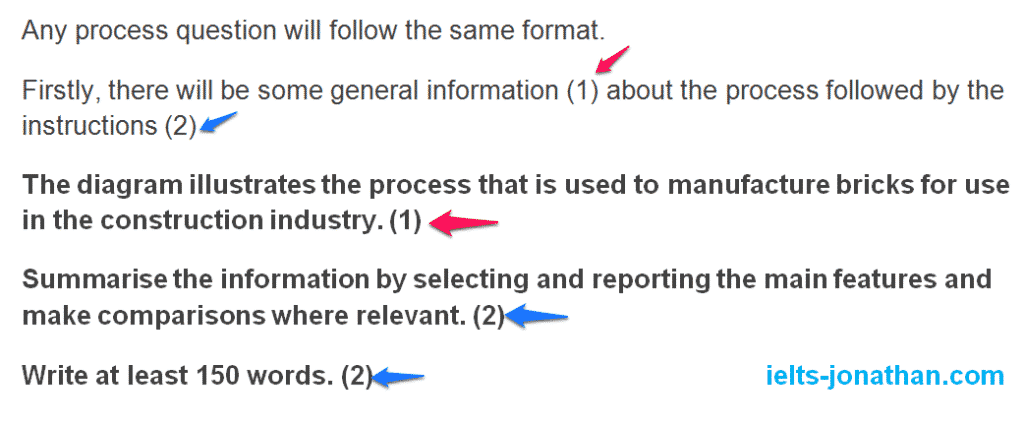
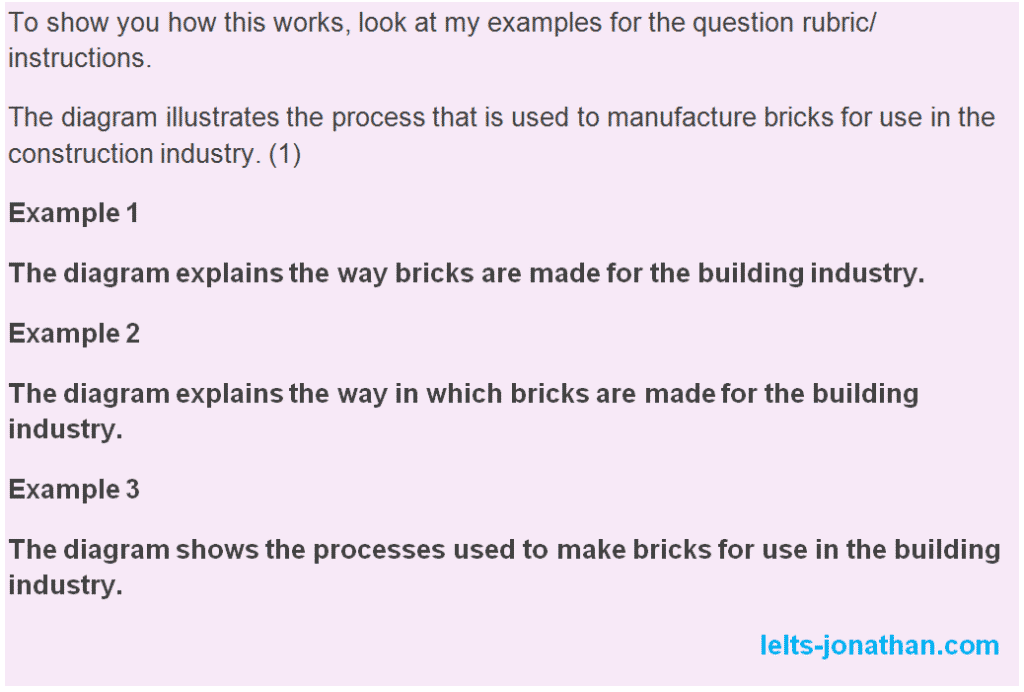




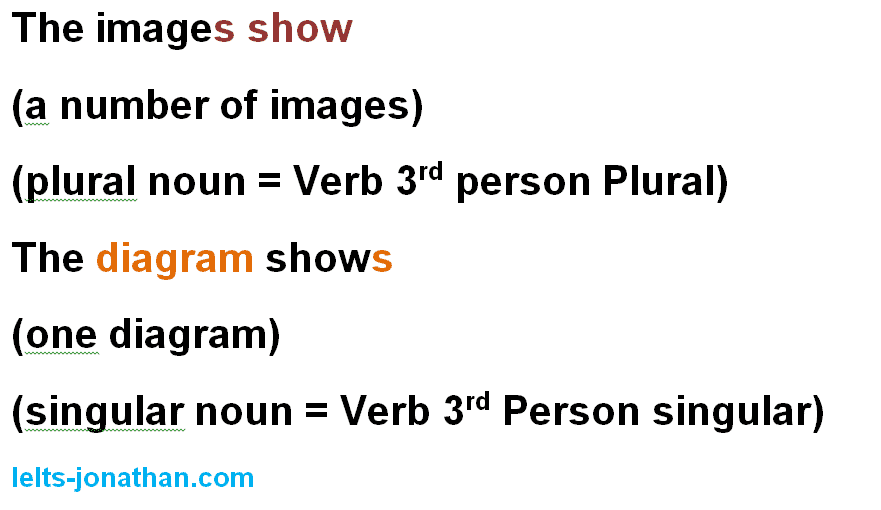
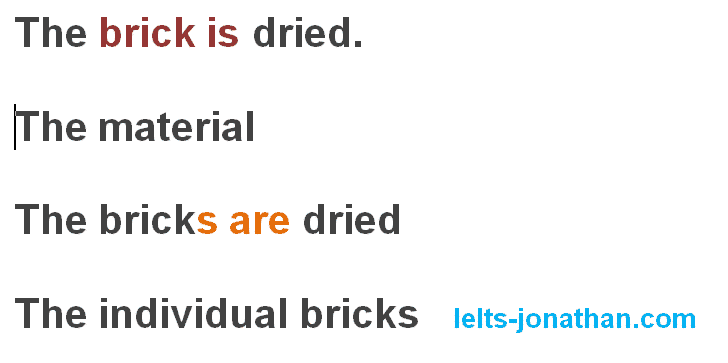


Was this helpful? Leave a comment :)